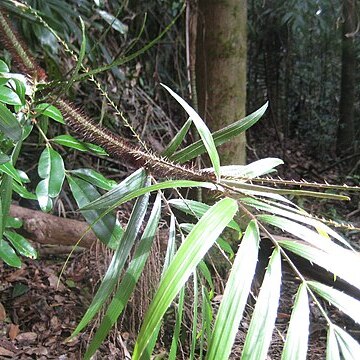Clustering climbing palm to 20 m tall; stems to 16 mm diam. Leaves ecirrate, to 1 m long; leaf sheaths flagelliferous, with dense needle-like brown spines to 10 mm long, randomly arranged; petiole 0–2 cm long, densely spiny; rachis flat adaxially, with retrorse, black-tipped spines. Pinnae 7–10 each side of rachis, regularly or irregularly arranged, lanceolate to elliptic, to 20 cm long, to 20 mm wide, acuminate, papyraceous, dark green adaxially, lighter green abaxially, with prominent midrib. Staminate and pistillate inflorescences sparsely branched, to 3 m long. Staminate flower to 7 mm long. Pistillate flower to 5 mm long. Fruit globose, to 16 mm diam., yellow.

